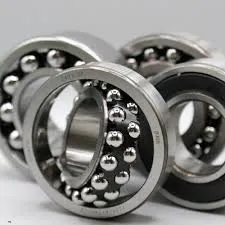
Nov . 06, 2024 05:09 Back to list
deep groove ball bearing design
Design of Deep Groove Ball Bearings
Deep groove ball bearings are one of the most commonly utilized types of bearings in various applications due to their versatility, durability, and ability to handle both radial and axial loads. Understanding the design principles behind these bearings is crucial for engineers and manufacturers in order to optimize performance and reliability in mechanical systems.
Basic Structure
At its core, a deep groove ball bearing consists of an outer ring, an inner ring, a set of balls, and a cage that holds the balls in place. The design features deeply grooved raceways in both the outer and inner rings, which allow for increased contact surface area between the balls and the rings. This design enhances load-carrying capacity, reduces friction, and minimizes wear over time.
Load Capacity
One of the primary considerations in the design of deep groove ball bearings is their load capacity. The deep groove profile enables the bearing to support significant radial loads, as well as some axial loads in both directions. The radial load is primarily supported by the balls' contact with the raceways, while axial loads can be accommodated due to the curvature of the groove. Designers often utilize calculations based on material properties, ball size, and the number of balls to ensure that the bearing can safely operate under expected load conditions.
Material Selection
deep groove ball bearing design

Material selection is another critical aspect in the design of deep groove ball bearings. Bearings are typically made from high-carbon chromium steel, which provides excellent hardness and wear resistance. However, other materials, such as stainless steel, ceramic, or plastic, can be chosen based on specific application requirements, such as corrosion resistance or weight reduction. The hardness and surface finish of the bearing components directly influence the bearing's overall performance, including its lifespan and ability to reduce friction.
Lubrication
Effective lubrication is essential for deep groove ball bearings to minimize friction and wear. The design often incorporates grease or oil lubrication systems. Greasing is commonly used in applications with lower speeds and loads, while oil is preferred for high-speed operations. Innovative designs, such as sealed or shielded bearings, help retain lubricant within the bearing and prevent contaminants from entering, further enhancing performance and longevity.
Operating Conditions
Understanding the operating environment is crucial in the design process. Temperature, humidity, and potential exposure to pollutants can significantly impact bearing performance. For instance, bearings operating in high-temperature environments may require special materials or lubrication techniques. Additionally, considering dynamic loads and varying speeds is vital to prevent premature failure and ensure reliable operation.
Conclusion
In conclusion, the design of deep groove ball bearings involves a careful balance of load capacity, material selection, lubrication, and environmental considerations. These design principles enable deep groove ball bearings to excel in a wide range of applications, from electric motors to industrial machinery. Engineers must continue to innovate and optimize these designs to meet the demanding needs of modern technology while ensuring reliability and efficiency in mechanical systems. As industries evolve, so will the design of deep groove ball bearings, paving the way for advancements in engineering and manufacturing.
Latest news
-
Premium Deep Groove Ball Bearings | High Speed & Reliability
NewsAug.29,2025
-
Durable Scaffolding Clamps - Secure & Reliable Tube Connectors
NewsAug.28,2025
-
Common Failures in Thrust Ball Bearings and Solutions
NewsAug.22,2025
-
How Tapered Roller Bearings Can Take Shock Loads
NewsAug.22,2025
-
Angular Bearings in High-Precision Spindles
NewsAug.22,2025
-
The Impact of Misalignment on Cylindrical Roller Bearing Performance
NewsAug.22,2025
